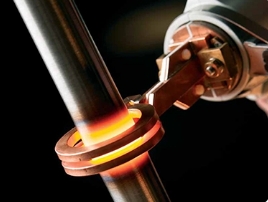- 04
- Dec
پس از اینکه قطعات سخت شده القایی فرآیند کوئنچ را کامل کردند، چه مواردی به طور کلی بازرسی می شوند؟
پس از اینکه قطعات سخت شده القایی فرآیند کوئنچ را کامل کردند، چه مواردی به طور کلی بازرسی می شوند؟
(1) کیفیت ظاهری
کیفیت ظاهری سطح کوئنچ شده قطعات نباید دارای ایراداتی مانند همجوشی، ترک و غیره باشد. سفید مایل به خاکستری به طور کلی نشان می دهد که دمای خاموش کردن بیش از حد بالا است. تمام سیاه یا آبی روی سطح به طور کلی نشان می دهد که دمای خاموش کردن کافی نیست. ذوب محلی و ترک های آشکار، بهمن و گوشه ها را می توان در طول بازرسی بصری یافت. نرخ بازرسی ظاهری قطعات تولید شده در دسته ها و دسته های کوچک 100 درصد است.
(2) Hardness
Rockwell hardness tester can be used for random inspection. The sampling rate is determined according to the importance of the parts and process stability, generally 3% to 10%, supplemented by file inspection or 100% file inspection. During file inspection, it is best for the inspector to prepare standard hardness blocks of different hardness for comparison, so as to improve the accuracy of file inspection. In the conditional automated production, the more advanced hardness inspection method has adopted the eddy current tester and other assembly lines to inspect piece by piece.
(3) منطقه سخت شده
برای قطعات نیمه کوئنچ شده، لازم است اندازه و موقعیت ناحیه کوئنچ شده بررسی شود. در تولید دستهای کوچک اغلب از خطکش یا کولیس برای اندازهگیری استفاده میشود، و همچنین میتوان از اسید قوی برای خوردگی سطح خاموش شده استفاده کرد تا برای بازرسی، ناحیه سفتشده سفید به نظر برسد. روش اچینگ اغلب برای تست های تنظیم استفاده می شود. در تولید انبوه، اگر سلف یا مکانیسم کنترل خاموش کننده قابل اعتماد باشد، معمولاً فقط بازرسی های تصادفی انجام می شود و میزان نمونه برداری 1٪ تا 3٪ است.
(4) Depth of hardened layer
The depth of the hardened layer is currently mostly inspected by cutting hardened parts to measure the depth of the hardened layer. So far, the metallographic method has been used in the past to measure the depth of the hardened layer in the past, and GB 5617-85 will be implemented in the future to determine its depth by measuring the section hardness of the hardened layer. The depth inspection of the hardened layer requires damage to the parts. Therefore, in addition to special parts and special regulations, only random inspections are generally used. Large-scale production of small parts can be spot-checked for one piece per shift or one piece for every small number of workpieces produced, and one piece for large-scale parts can be spot-checked every month. When using advanced non-destructive testing equipment, the sampling rate can be increased, and even 100% can be used. For example, if the surface of the workpiece allows the Leeb hardness tester to indent, then it can be checked piece by piece with the Leeb hardness tester.
(5) تغییر شکل و انحراف
Deformation and deflection are mainly used to check shaft parts. Generally, a center frame and a dial indicator are used to measure the swing difference or deflection of the parts after quenching. The pendulum difference varies according to the length and aspect ratio of the part. The induction hardened part can be straightened, and its deflection can be slightly larger. Generally, the allowable pendulum difference is related to the grinding amount after quenching. The smaller the grinding amount, the smaller the allowable pendulum difference. The diameter grinding allowance of general shaft parts is usually 0.4~1mm. The pendulum difference after the parts are allowed to be straightened is 0.15~0.3mm.
(6) Crack
The more important parts need to be inspected by magnetic particle inspection after quenching, and factories with better equipment have used phosphors to show cracks. Parts that have been magnetically inspected should be demagnetized before being sent to the next process.

